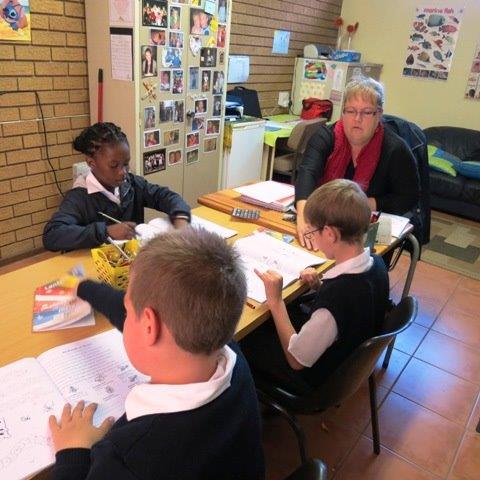Speech Therapy / Spraakterapie
The Speech Therapy and Audiology Department at Lantern School comprises of 9 team members. Learners requiring Speech Therapy are seen on a rotational basis, twice a week, either individually, or in a small group of 2 or 3 children. The size of the group of each child will depend on the needs of the learner. Extra Speech Therapy stimulation will be provided for children requiring more specific attention (e.g. children who stutter or children with an auditory processing disorder). Speech Therapists work within a multidisciplinary team (with Psychologists, Occupational Therapists, Remedial Therapists, and Teachers). Team decisions are made regarding appropriate placement and therapy for each new admission seen.
Our Role
At Lantern School, the Speech Therapists provide speech and language assessments for every new child admitted and thereafter speech and language therapy based on the diagnosis made within the multi-disciplinary team. Speech Therapy encompasses a variety of areas namely: motor speech 1 disorders (articulation, phonology, stuttering and oral apraxia), voice disorders, receptive and expressive language disorders, aural rehabilitation, auditory processing disorders, and pragmatics.
Audiologists are required to provide a hearing screening with every new speech and language assessment conducted at the school. Should the results of the hearing screening be abnormal, a referral will be made to an Audiologist with the appropriate audiological equipment in order to conduct a full hearing assessment. A referral may also be made to a General Practitioner (GP) or Ear, Nose, and Throat (ENT) Specialist depending on the results found.
Our aim is to ensure that learners will be able to pass matric at a GDE level through the extra stimulation provided. If possible, a learner may be sent back into a mainstream school depending on the progress made. Learners are also provided with amanuensis if they are unable to read or write appropriately. The therapist will either read or write answers verbatim for a test paper provided in order to ensure that the child is tested on their knowledge and not restricted by their inability to read or write appropriately.
Relevant Definitions
Hearing Loss:
A decrease in loudness levels at specific frequencies spanning from 250Hz to 8000Hz. The hearing loss may be described according to the degree (mild to profound), type of hearing loss (sensor neural, conductive or mixed hearing loss) and hearing loss configuration. The hearing loss may be resolved with antibiotics, surgery or hearing aid/cochlear implant rehabilitation.
Auditory Perceptual Difficulties:
Generally accompanied with normal hearing levels auditory perceptual difficulties refers to problems processing auditory stimuli. Difficulties are compartmentalised into: auditory analysis and synthesis (blending and breaking up of sounds), rhyming, syllabification (breaking up of words), closure (filling in missing information), discrimination (ability to hear differences in sounds), auditory memory (storing and recalling of information), and auditory sequencing (correct ordering of digits, words and stories).
Receptive Language:
This is defined as the comprehension of language or decoding of a message with appropriately attached meaning. It's the ability to hear a word, store it in the brain, form a concept, attach a meaning, incorporate it into one's vocabulary, compare, categorise, form associations, reason, form abstract thought, understanding of figurative language, and production of the thought independently. This is done using words, sentences, and grammatical structures.
Expressive Language:
The ability to express oneself in an age appropriate way. It is the encoding of a message. When a message is conveyed, the words are selected from memory in a sequenced manner. The information is obtained from previous experience. Neuro-muscular coordination is then required to physically produce the message appropriately. Prosody characteristics (pitch, fluency, intonation and speed) are used in conjunction with this to convey the message. Body language and pragmatics help to make the message better understood. A person then receives auditory feedback which allows the messenger to know that the message was correctly encoded and received. This is conveyed using words, sentences and correct grammatical structures.
Links
Contact information
Phone
011 760 1096/7Fax
011 763 2282Physical Address
CR South Road & Albertina Sisulu Road, LindhavenH/V Suidweg & Albertina Sisuluweg, Lindhaven

